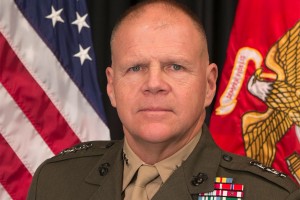
What Marines Want From Their Next Commandant
The U.S. Marine Corps is in the midst of a leadership shuffle.
Gen. Joseph Dunford, the current commandant, has been tapped by the Obama administration to replace retiring Army Gen. Martin Dempsey as chairman of the Joint Chiefs of Staff. His confirmation hearing is set for Thursday.
Defense Secretary Ash Carter last week surprised many by nominating a three-star general, Lt. Gen. Robert Neller, an infantry officer and head of Marine Corps Forces Command in Norfolk, Virginia, rather than a four-star to succeed Dunford as commandant.
Regardless of whether Neller is confirmed by the Senate later this summer or in the fall, a handful of enlisted Marines interviewed by Military.com were quick to share what they’d like to see from their next commandant. Here are five items they cited as priorities:
1. Relaxed Tattoo Policy.
So-called sleeve tattoos — those that cover most of or the entire arm or leg — are increasingly popular among military members and civilians alike. Even Sydney Leroux of the World Cup-winning U.S. women’s soccer team has one. Not surprisingly then, many Marines want the new leader of the service to relax recent policy changes they argue unfairly penalize those who like ink on the limb.
Under then-Commandant James Conway, the Corps in 2010 adopted tougher regulations that limited the number, size and placement of tattoos, and banned sleeves outright. Marines who already had the forbidden tattoos were supposed to be exempted from the policy change, but some said they were effectively barred from applying for certain jobs.
“I get criticized for it, even though I’ve had it before the policy came into effect,” said a 33-year-old staff sergeant and aviation ordnance technician, who requested anonymity to speak freely about the issue without hurting his chances for promotion. “My entire chain of command — my officer in charge, my former officer in charge, my commanding officer — recommended that I put in a warrant officer package, and I can’t because I have a sleeve tattoo.”
He added, “You join the military and they want to control your appearance to make you look clean-cut. I guess to them having tattoos makes you look unprofessional. I don’t think tattoos determine whether a person is professional or not. He’s either professional when he carries out his business or he’s not. The tattoos shouldn’t make a difference.”
He and others also said they wanted an end to the requirement to roll up sleeves on the desert Marine pattern combat utility uniform during the summer months and to wear new rugged all-terrain boots in garrison.
2. New Weapons and Equipment.
Automatic spending caps known as sequestration have made it harder for the services to train and equip troops. As a result, the Marines said, some weapons and equipment, including aircraft such as the UH-1Y Venom light-utility helicopter, sit idle while maintainers wait for parts to ship.
Indeed, many of the choppers have been sidelined because of the issue, according to Staff Sgt. Daniel Karczewski, 27, an aviation logistics specialist with the 3rd Marine Aircraft Wing at Marine Corps Air Station Miramar in San Diego.
“We got planes that are going to be grounded for the next five years because there are no parts for them,” he said. “Those pilots are going to school for two to three years to learn to fly a plane or a helicopter that they can’t even fly.” He added, “If I were talking to the general, I’d tell him you need to fight harder in Congress to get funding.”
Cpl. Michael Garcia, 22, a motor vehicle operator with 1st Battalion, 11th Marines, at Camp Pendleton in California, agreed. He said he deployed to a Middle Eastern country last year with a unit that drove Humvees rather than newer blast-resistant trucks such as the Mine-Resistant Ambush-Protected vehicles, or MRAPs.
Whether they’re aircraft, vehicles or radios, “some of what we have is really old,” he said. “We spend countless dollars fixing this equipment. We might as well spend it on new equipment that’s going to last us longer.”
3. Gender-Neutral Fitness Standards.
The Marines interviewed by Military.com said that as the Corps moves to open more combat jobs to females, it should adopt gender-neutral standards for physical fitness and combat fitness tests.
Under a previous directive from then-Defense Secretary Leon Panetta, the military services must open ground combat units to women by the end of the year or explain why any must remain closed. The Pentagon lifted its ban on women serving in such roles in 2013, but gave the services time to integrate female troops into male-only front-line positions.
The Marine Corps in 2012 allowed women to take the Infantry Officer Course, though none has yet passed the physically challenging 13-week program.
“We have issues even in the air wing with females not being able to lift the heavy ammo can, so we have to accommodate for them,” the aviation ordnance technician said, referring to the 100-pound-plus canister that holds 20mm rounds for the AW-1W Super Cobra attack helicopter and F/A-18 Hornet fighter jet.
“There should be one physical fitness test and one combat fitness test. … If we’re going for equality, the females should be able to do the same test as the males.”
4. Manpower Reductions at the Top.
Like the Army, the Marine Corps has been downsizing after more than a decade of largely ground wars in Iraq and Afghanistan.
The Corps had almost 184,000 Marines as of May 31, according to Pentagon personnel statistics. While it budgeted to have that amount in the next fiscal year, which begins Oct. 1, it could be forced to shrink to 174,000 Marines by the end of 2017 if sequestration remains in effect.
The aviation ordnance technician said the reductions have targeted too many mid-level enlisted personnel.
“They’re cutting the wrong people from the wrong ranks,” he said. “It’s wrong. It should have started from the top down. You’ve got all these high-ranking people just holding up billets. They’re not really contributing to the Marine Corps. They’re just sitting there trying to collect to 30 years when they could get out” and make room for junior and mid-level enlisted personnel to advance.
5. Air-Conditioned Barracks.
Karczewski said he’s already talked to two generals about adding air-conditioning units to barracks, but nothing has been done about it.
The issue isn’t just about creature comforts; better regulating the temperature and humidity in the housing units would help to reduce mold, which is a chronic problem in many locations, and keep the force healthy, he said.
The decades-old barracks house mostly young, single Marines and come equipped with neither central air conditioning nor window AC units — yet at least some now feature state-of-the-art video cameras to monitor the residents, Karczewski said.
“I’m a staunch advocate for the junior troops because I was a junior troop and I lived in those crappy barracks,” he said. “If I had the energy and I didn’t want to destroy my career, I would fight for more comforts in barracks all over the Marine Corps.”
— Brendan McGarry can be reached at Brendan.McGarry@military.com.




